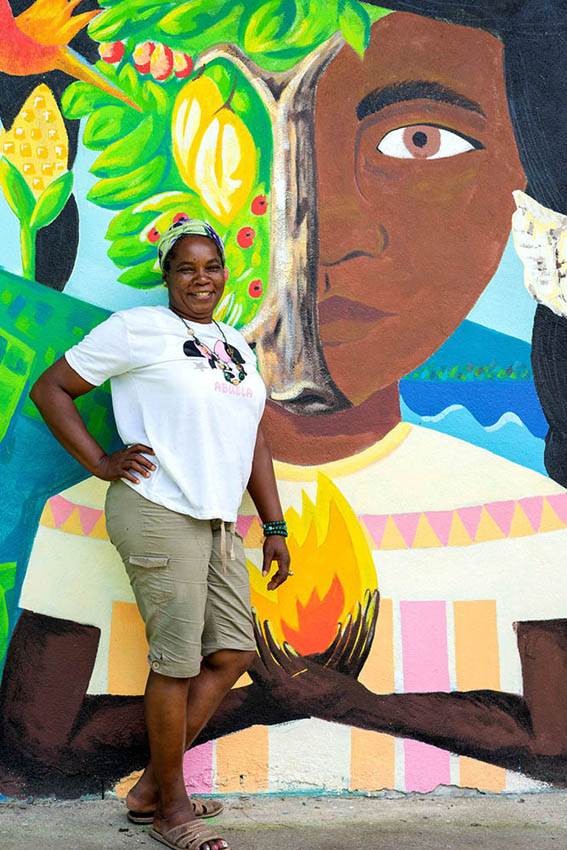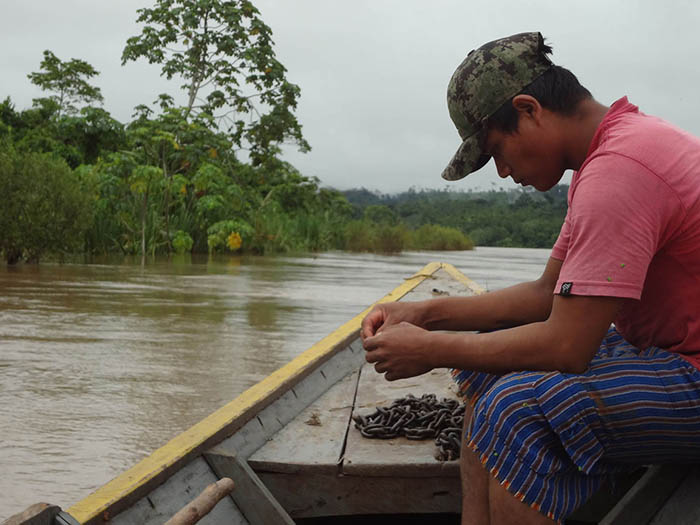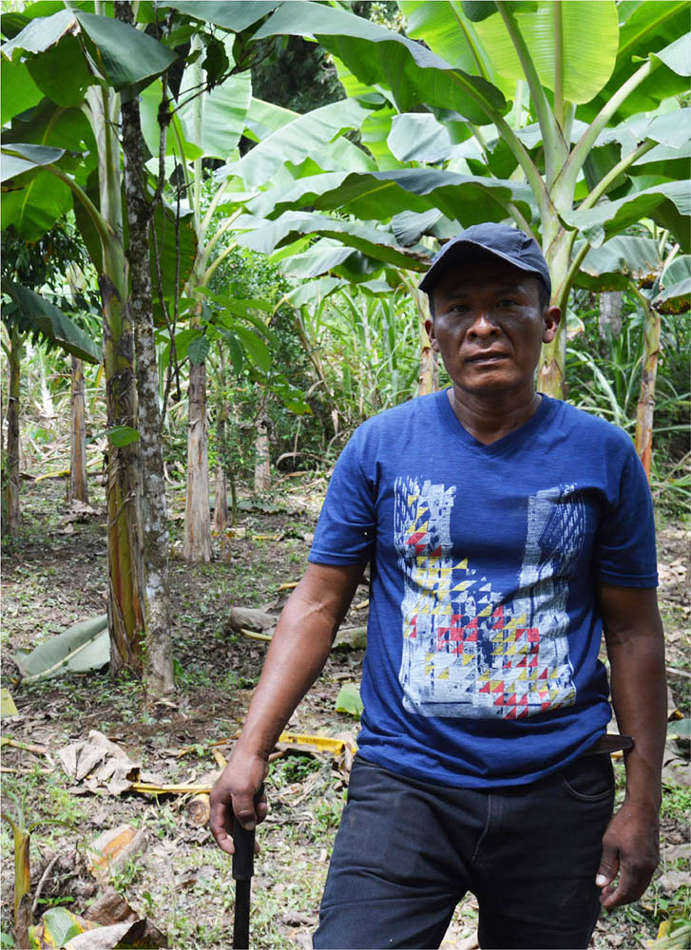Five types of measures for mitigating climate change in indigenous and tribal territories

Native indigenous leader of the Bribri People, Association of Indigenous Women of Talamanca (ACOMUITA), Talamanca, Limón Province, Costa Rica.
The recognition of collective land rights, payment for environmental services, and community forest management help to reduce forest destruction in indigenous and tribal territories. Unfortunately, these policies have weakened in recent years and new threats to the communities and forests have appeared. This section presents measures to address these threats.
The growing pressure on the population and forests of the indigenous and tribal territories requires a major holistic response, including public and private investments and policies, procedures, and institutional frameworks. Key components include:
- strengthening territorial rights;
- compensating environmental services;
- promoting community forestry;
- reaffirming traditional cultures and knowledge; and
- supporting territorial governance and indigenous and tribal organizations and institutions.
Given the strong synergies between these components, they should be thought of as a package – not just a menu to select options from.
a. Effective collective territorial rights
Formal recognition of indigenous and tribal peoples’ collective rights over their territories has been a key factor that explains the territories’ low carbon emissions. Legal certainty about rights over land, forests, and forest carbon limits encroachment and makes it easier to access funds, services, and markets.
Latin America and the Caribbean has gone farther than Africa and Asia in recognizing traditional rural communities’ collective rights over their ancestral territories (RRI, 2018). All Central and South American countries have laws recognizing these rights except El Salvador, Suriname, and Uruguay (Wily, 2018). Through diverse legal mechanisms, the governments of the region have recognized the indigenous and tribal communities’ long-term property or usufruct rights to more than 275 million of hectares of land and 200 million hectares of forests, the majority of which is in the Amazon Basin.32
Despite those developments, the region’s indigenous and tribal peoples have customary rights over tens of millions of hectares that governments have yet to recognize (RRI, 2020). It is hard to say how much land remains to be recognized since much of the unrecognized area has not been mapped. Nonetheless, the Plurinational State of Bolivia, Brazil, Peru, Suriname, and the Bolivarian Republic of Venezuela probably each still have more than ten million hectares of unrecognized indigenous and tribal territories, most of which has forest (ACT, 2010; IBC, 2016; Del Popolo, 2017; Mongabay, 2018; RAISG, 2019; Tamburini, 2019).33 Argentina, Chile, Colombia, Ecuador, Guatemala, Guyana, Honduras, Panama, and Paraguay also have significant unrecognized areas (Rapoport Center, 2009; Del Popolo, 2014; Dooley and Griffiths, 2014; Vergara-Asenjo and Potvin, 2014; ECLAC, 2017; Dubertret, 2017; Atkinson et al., 2018; Halvorson, 2018; Agard et al., 2019; RAISG, 2019; FAPI, undated). Practically all the land indigenous peoples and Afro-descendants claim in Costa Rica and Nicaragua has been titled, but a significant portion of that has been illegally usurped (Finley-Brook, 2016; Del Popolo, 2017; Bryan, 2019).
Among the factors hindering recognition of indigenous and tribal territorial rights are:
- expensive, complex, and lengthy procedures;
- insufficient public investment in land administration for these areas;
- weak inter-institutional coordination between government agencies;
- overlapping rights to the same land;
- poorly designed, out-of-date, incomplete, and untransparent land registries;
- political and bureaucratic resistance to recognizing collective rights; and
- lack of awareness about the environmental and social benefits that recognizing these areas provides (Bustillos, Aguilar, and Grimaldo, 2015; Márquez Porras, Eguiguren Riofrío and Vera, 2018; Monterroso and Larson, 2018; Notess et al., 2018; Monterroso et al., 2019).

Indigenous women leader from the Guaraní Kaiowá People, Indigenous Territory of Dourados, Mato Grosso do Sul, Brazil.
Private companies that come to an area for the first time often find it easier and faster to obtain title than communities that have been there for centuries (Notess et al., 2018).
Another common problem is that communities, organizations, and territorial authorities that try to establish their rights as the territories’ legal owners or managers find it hard to register and be recognized as legal entities. Some countries do not recognize indigenous or tribal communities as legal entities. Others have procedures and practices that hinder registration by communities or their organizations and authorities (F. Edouard, personal communication, April 26, 2020).
Recognition of collective tenure rights does not always have meaningful short-term effects where there is little pressure on forests. With or without formal land rights, deforestation is low there (Buntaine, Hamilton, and Millones, 2015; BenYishay et al., 2017; Blackman and Veit, 2018). However, governments find it easier to formally recognize rights over territories before pressure increases and multiple groups compete for the same resources or different resources in the same areas. Currently, pressure seems to be increasing practically everywhere (Walker et al., 2020).
The key question is not whether one can justify investments to formalize tenure rights over forestlands that still are not threatened, it is whether those rights will suffice to curtail forest destruction once the pressure rises. A priori, there is no way to definitively answer that question. However, the evidence suggests that formal tenure rights can be effective even when forests are under pressure, especially when communities organize to defend their rights, and governments support them (Bayi, 2019).
This last point is key, since there are places where communities have recognized land rights, but governments do little to ensure respect for those rights. Before issuing a land title, governments are expected to go through a land regularization (“saneamiento”) process. They are supposed to identify competing land claims, assess their validity, cancel previous titles or registration that lack legal basis, establish rules of co-existence with third parties allowed to stay, and plan for the removal and possible relocation of other third parties. However, this often never happens or takes years to be completed (Finley-Brook, 2016; IACHR, 2019; Tamburini, 2019). Where property rights are clear, governments are supposed to intervene if a territorial property is illegally encroached upon, but they do not always do so (McSweeney et al., 2018; Bryan, 2019; Correia, 2019).
Weak efforts by some governments to ensure respect for collective property rights have contributed to increasingly frequent violent attacks against territorial leaders and inhabitants. Hundreds of indigenous or Afro-descendant community leaders have been killed since 2017, especially in Brazil, Colombia, Guatemala, Honduras, Mexico, Nicaragua, and Peru, where governments have yet to implement effective measures to stop the violence (Global Witness, 2018, 2019, 2020).
In practically all Latin American countries, sub-soil rights belong to the state. There are also some countries where governments do not recognize indigenous and tribal peoples’ collective rights over forests, water, or forest carbon (Anthias and Radcliffe, 2013; Ortiz Aranda and Madrid Zubirán, 2017; Anderson et al., 2018). As a result, governments often grant companies mining, oil, and forestry concessions inside the territories, and the communities have no way to stop company personnel from entering and damaging their forests and rivers.
In Ecuador, for example, almost half the area in Amazonian indigenous territories (48 percent) has overlapping petroleum concessions, which explains much of the forest degradation there (Walker et al., 2020). It may also be one reason some studies found that titling indigenous territories reduced deforestation less in Ecuador than in other neighboring countries (Blackman and Veit, 2018).
All Latin American countries have approved the United Nations Declaration on the Rights of Indigenous Peoples (UNDRIP). Most have ratified the International Labor Organization (ILO) Protocol 169 and have national legislation that recognizes indigenous and tribal peoples’ right to Free, Prior and Informed Consent (FPIC) (ECLAC and FILAC, 2020).34 So, in principle, there shouldn’t be any mining, petroleum or forestry investment in indigenous and tribal territories without local consent. However, that is not always the case (Anaya, 2015; Wright and Tomaselli, 2019). Some countries do not consult to determine whether the communities support the projects, or the consultations use inadequate methods, which do not properly reflect community concerns.
The international norms do not allow governments to establish protected areas in indigenous and tribal territories without the inhabitants’ consent, but that happens frequently in many countries (UN, 2016). Many indigenous and tribal leaders complain that government environment officials fail to consult them about decisions affecting their territories, restrict their traditional hunting, fishing, and cultivation practices, and monopolize the available funds. In a few cases environmental agencies have even evicted indigenous communities from their territories against their will.35 In some countries, including Brazil, Ecuador, Honduras, and Panama, when governments designate someplace as a protected area it become much harder or even impossible for indigenous or tribal communities to attain recognition of their rights over that area (Springer and Almeida, 2015) (Box 2).

Young indigenous man navigating the Ucayali River (Peru).
Box 2 Titling indigenous territories that overlap with protected areas in Panama
Panama was a pioneer in the region with regards to indigenous peoples’ territorial rights. It recognized the first indigenous comarca (Guna Yala) in 1937, and the national Constitution of 1972 acknowledges indigenous rights to collective property. By 1997, the country had five comarcas, covering more than 12 percent of the country (1.6 million hectares), each established by a separate law.
In 2008, the Congress approved Law 72, known as the Collective Territories Law, which created a mechanism for titling smaller indigenous territories. The legislators expected it to be used to title almost 700 000 hectares in some thirty territories. However, the process advanced slowly. As of 2015 only five of the territories had received title.
As in other countries, several of Panama’s comarcas overlap with protected areas. However, those overlaps did not impede them from being titled.
Nevertheless, after 2015 some government officials began to question if indigenous territories could legally receive title for land that overlapped with protected areas. That controversy paralyzed the titling process, since practically all the indigenous territories had overlaps.
The officials that raised the issue never produced a formal document laying out their position or fully clarified whether they were concerned mostly with legal or environmental issues. In any case, more than half the country’s forests are in territories indigenous peoples have customary rights to and almost all those territories have low deforestation rates. The same goes for the specific territories indigenous peoples had been trying to get titled. In these territories the proportion of the land that still has forest cover is about the same as in the non-indigenous protected areas.
Between 2016 and 2018, indigenous leaders met frequently with the national authorities to demand their land titles. However, the issue was not resolved until a new government took office in 2019. In November 2019, the Ministry of Environment issued Ministerial Decree 0612, which recognized indigenous peoples’ rights to their ancestral lands, even when they are in protected areas, citing national laws and international treaties to justify that conclusion (Ministerio de Ambiente, 2019). The Ministerial Decree opened the door to titling the remaining 25 indigenous territories without title. The communities were only required to submit “sustainable land use and community development plans” for approval by the Ministry of Environment. Ministerial Decree 0612 may also facilitate recognition of the country’s sixth comarca, the Naso Tjër Di comarca, currently held up in the courts. SOURCE: Vergara-Asenjo and Potvin, 2014; Halvorson, 2018; Republic of Panama, 2019.

Producer of the Naso People, Solong, Bocas del Toro Province, Panama.
Without community participation, protected areas that have communities inside or nearby have little chance of being well conserved (Mohedano-Roldán, Duit and Schultz, 2019). Some governments have established successful co-management schemes with indigenous and tribal communities (Rivera-Ángel and Lopes-Simonian, 2019; Dupuits and Cronkleton, 2020; Painter et al., 2020), however, these remain more the exception than the rule. Most countries have yet to begin a serious intercultural dialogue between the environmental authorities and indigenous and tribal territorial leaders that would help them to learn from co-management experiences and expand them to larger areas.
Given the growing threats of invasion by invasion by external actors and initiatives imposed on the indigenous and tribal peoples without their permission, much greater efforts are needed to guarantee indigenous and tribal peoples collective territorial rights. This includes investments and policy dialogues oriented at:
- Strengthening the government agencies responsible for these activities and the coordination between them.
- Speeding up the communal territories’ mapping, ethnological studies, demarcation, titling (or registration), and regularization (“saneamiento”).
- Delimiting and marking the territories’ boundaries.
- Monitoring, reporting, and punishing the illegal usurpation of communal property.
- Promoting alternative conflict resolution mechanisms.
- Facilitating the registration and legal recognition of communities and their organizations and territorial authorities.
- Improving the updating, accuracy, and transparency of the land registries and other information systems related to indigenous and tribal territorial authorities and tenure.
- Promoting co-management of protected areas inhabited by indigenous and tribal communities and intercultural dialogues between the environmental authorities and the communities.
- Ensuring that communities can exercise their right to Free, Prior and Informed Consent (FPIC) with regards to investments and policies that affect their territories.
- Guaranteeing the right to life and physical security of territorial leaders and inhabitants and ensuring those responsible for violating these rights are punished.
- 32 Each country has its own legal framework that regulates those collective rights. These vary with regard to: legal hierarchy (constitutional, ordinary law, decree); who owns the property (the indigenous or tribal community, national or municipal government, civil association, cooperative, or development association); the procedures used to recognize and register the territory and its owners; the bundle of rights provided (e.g. self-government, exclusion, management, due process); the groups benefited (e.g. indigenous, tribal, riverine, campesinos of varied ethnicities); and the number of communities per territory (i.e. one, multiple) (Roldán Ortega, 2004; Herrera-Garibay and Edouard, 2012; RRI, 2012; ECLAC and FILAC, 2020). To analyze the environmental and social implications of these differences merits a separate study.
- 33 Most unrecognized Bolivian and Peruvian indigenous territories are in the lowlands and Amazon, respectively. In Brazil, the biggest deficit is in Quilombolo territories in the Amazon and the northeast and indigenous territories outside the Amazon.
- 34 In the Plurinational State of Bolivia, Ecuador, Mexico, and the Bolivarian Republic of Venezuela the right to FPIC is enshrined in the Constitution. Most of the other countries have laws or regulations that recognize those rights (ECLAC and FILAC, 2020).
- 35 On the other hand, the designation of protected areas has helped many indigenous and tribal communities to exclude the unwanted entrance of third parties and protect their natural resources.


